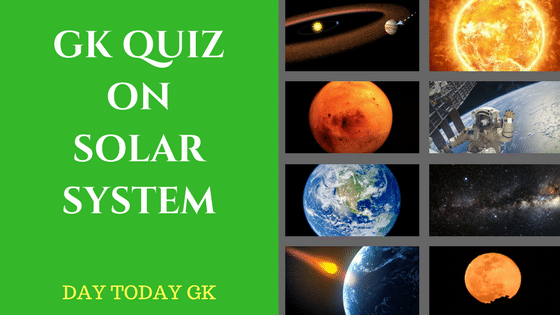GK Quiz on Solar System
GK Quiz on Solar System is one of the most common topics in all competitive exams under General Knowledge. Space Exploration is the emerging field and it involves searching in the Outer Space. Lots of Scientific Researches are going on in this particular field.
What is Solar System?
In simple words Solar System nothing but the Sun and all the objects that orbit around it. Those objects that orbit the Sun are Planets, Moons, Small Solar System Bodies..etc. The Solar System formed 4.6 billion years ago.

GK Quiz on Solar System
Take this amazing GK Quiz on Solar System and Share Your Marks in the comment section
GK Quiz on Solar System : Questions 1 to 10
1. Which of the following is FALSE regarding the Moon?
a) There is no dark side of the Moon
b) The Moon is slowly drifting towards Earth
c) There is no atmosphere on the Moon
d) The rise & fall of tides on Earth is caused by the Moon
2. In Solar System, the majority of the known asteroids orbit the Sun in a band between the orbits of Mars and _________.
a) Earth
b) Venus
c) Jupiter
d) Saturn
3. The word asteroid was coined by
a) Graham Shelly
b) William Herschel
c) David Hopkins
d) Paul Bishop
4. Olympus Mons, the largest volcano in the solar system, is in which of the following planets?
a) Mercury
b) Jupiter
c) Neptune
d) Mars
5. Which of the following statement is FALSE?
a) Asteroids are small, rocky objects that orbit the Sun
b) Asteroids are regular in shape
c) There are more than 6 Lakh known asteriods in solar system
d) Pluto is a dwarf planet
6. The largest Moon in the Solar System is ________.
a) Callisto
b) Europa
c) Setala
d) Ganymede
7. _______ is the largest dwarf planet in the Solar System.
a) Ceres
b) Makemake
c) Eris
d) Haumea
8. Which of the following statement is FALSE regarding the Sun?
a) The Sun accounts for 99.86% of the mass in the solar system
b) The energy created by the Sun’s core is nuclear fission
c) It takes eight minutes for light reach Earth from the Sun
d) The Sun generates solar winds
9. Which of the following statement is TRUE regarding Mercury?
a) Mercury is the smallest planet in the solar system
b) After the Earth, Mercury is the second densest planet
c) The MESSENGER probe was launched to explore Mercury’s high density
d) All are True
10. Phobos and Deimos are Moons of ________.
a) Jupiter
b) Mars
c) Venus
d) Saturn
GK Quiz on Solar System : Questions 11 to 20
11. Which planet in the Solar System is nicknamed as “The Ringed Planet”?
a) Mercury
b) Neptune
c) Uranus
d) Saturn
12. Which of the following statement is FALSE regarding Saturn?
a) Saturn has the fastest winds of any other planet
b) Saturn is the least dense planet in the solar system
c) Saturn has 150 moons and smaller moonlets
d) Saturn’s moon is Ganymede
13. Spacecrafts Pioneer 11, Voyager 1 and 2 and the Cassini-Huygen mission are associated with _______.
a) Saturn
b) Mars
c) Venus
d) Jupiter
14. Name the planet discovered by Jean Joseph Le Verrier?
a) Mercury
b) Neptune
c) Uranus
d) Venus
15. The largest object in the Kuiper belt is _______.
a) Neptune
b) Ceres
c) Pluto
d) Makemake
16. Which planet is referred as “Ice Giant”?
a) Neptune
b) Uranus
c) Mars
d) Saturn
17. The Allende Meteorite crashed to Earth over
a) Mexico
b) Australia
c) India
d) Nepal
18. The Hubble Space Telescope (HST) was built by
a) Japanese Space Agency
b) United States Space Agency
c) Russian Space Agency
d) Indian Space Agency
19. __________ is the closest large galaxy to the Milky Way.
a) Triangulam
b) Antennae
c) Andromeda
d) Whirlpool
20. ___________ is the only large moon in the solar system to orbit in the opposite direction to its planet’s rotation.
a) Charon
b) Triton
c) Lo
d) Deimos
We hope you have learned something new from our GK Quiz on Solar System.
Share your marks in the comment section & give your valuable feedback about GK Quiz on Solar System.










